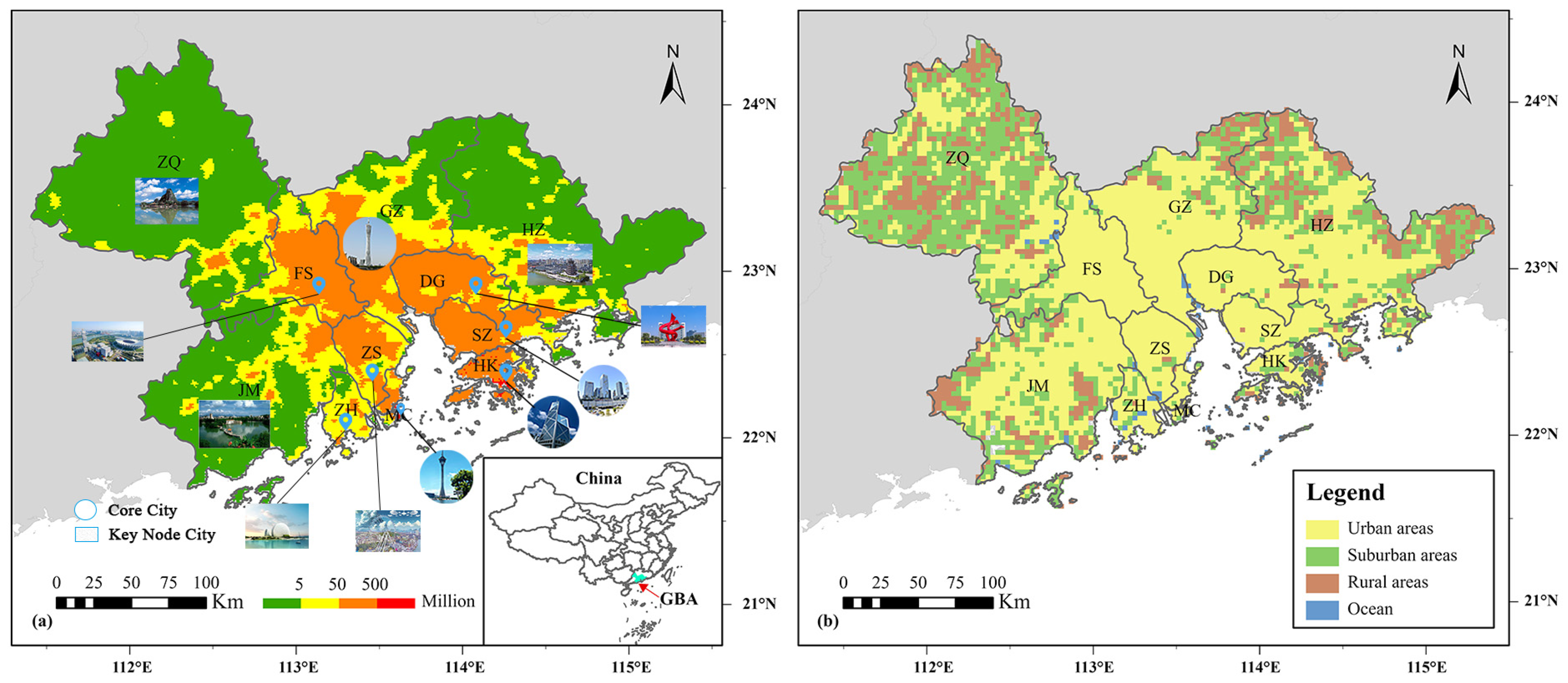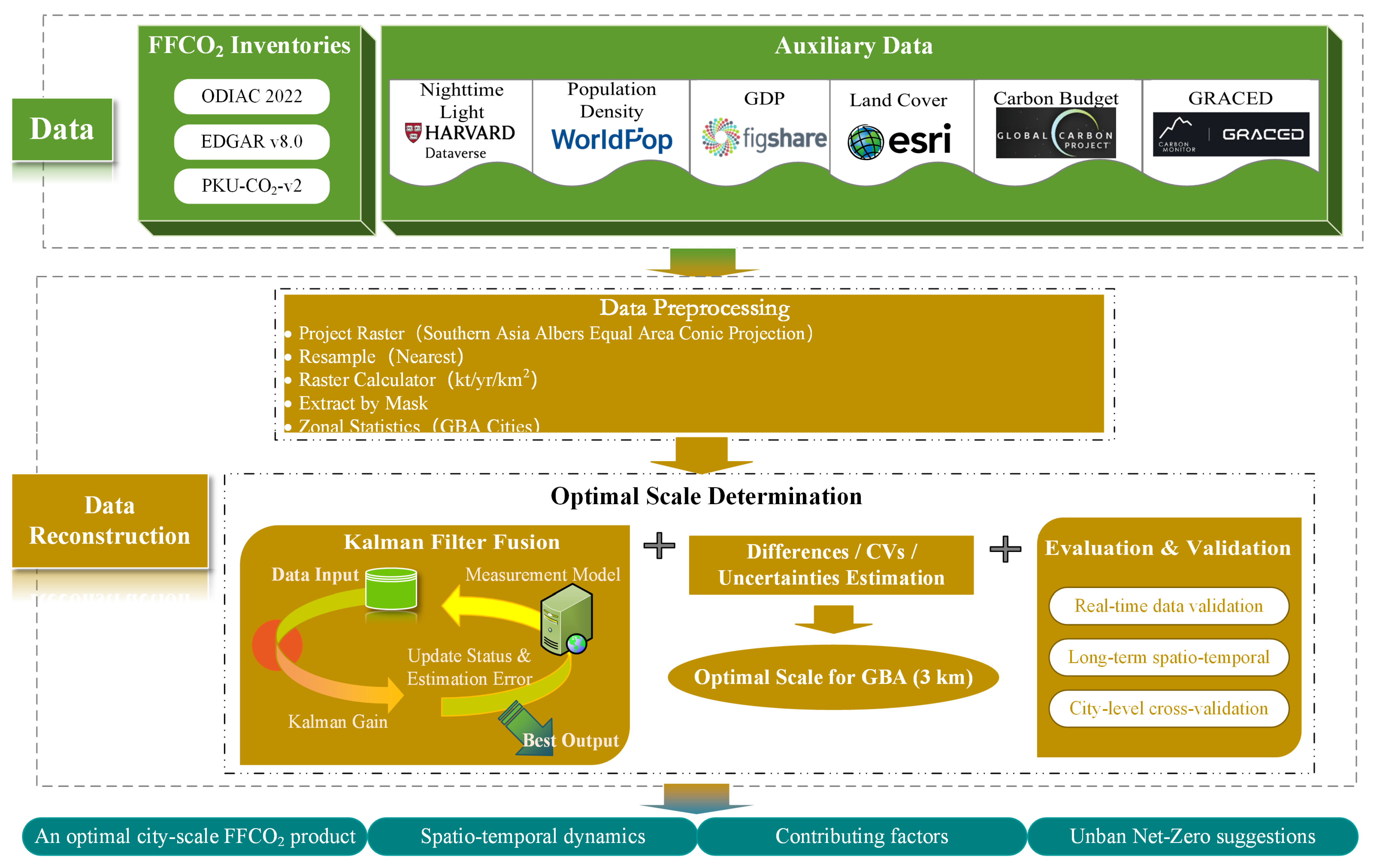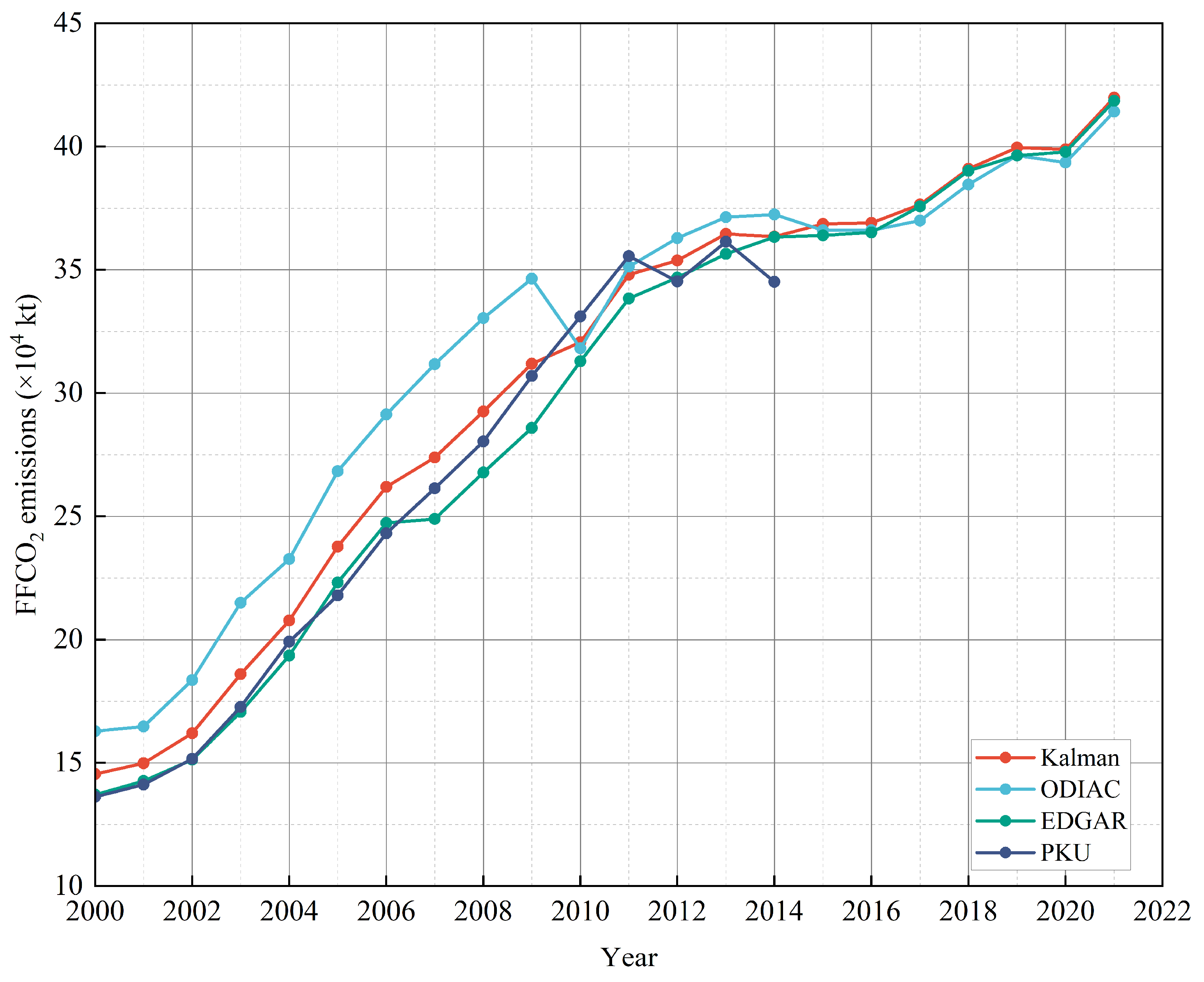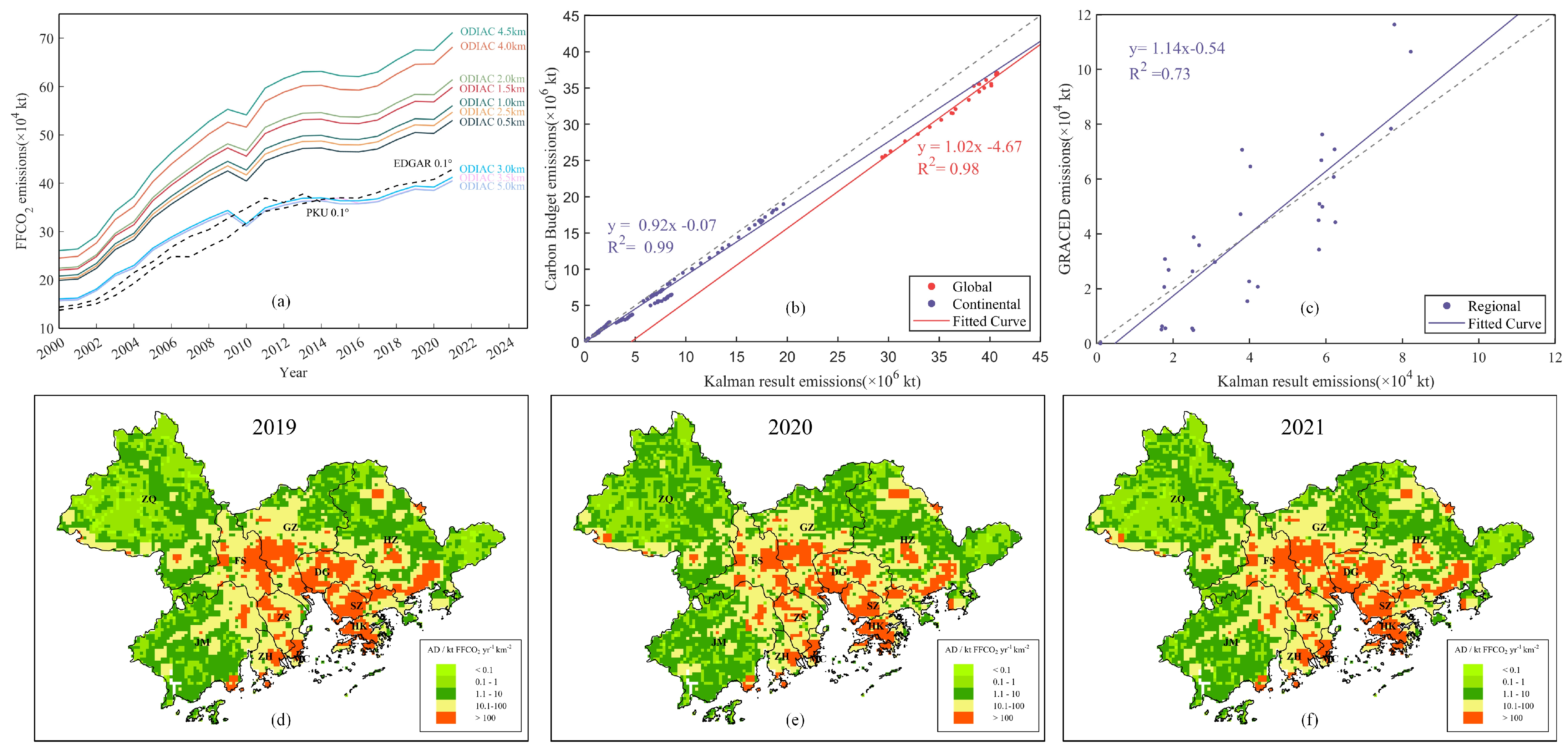Advancing Regional–Scale Spatio–Temporal Dynamics of FFCO2 Emissions in Great Bay Area
Abstract
1. Introduction
2. Materials and Methods
2.1. Study Area
2.2. Gridded High–Resolution FFCO2 Emission Inventories and Auxiliary Socio–economic Data
| Datebase | EDGARv7.0 | ODIAC2022 | PKU–CO2–v2 | GRACED | |
|---|---|---|---|---|---|
| Property | |||||
| Level | National–level data | National– and subnational–level data | National– and subnational–level data | Global and national | |
| Methodology | Bottom–up, transparent, and IPCC–compliant approach | Downscaled with multiple spatial proxy data (geographical location of point sources, satellite observations of nightlights, and aircraft and ship fleet tracks, etc.) | Bottom–up apparent consumption | Hybrid methods | |
| Time window | 1970–2021 | 2000–2021 | 1960–2014 | January 2019–October 2023 | |
| Spatial resolution | 0.1° × 0.1° | 1 km × 1 km/1° × 1° | 0.1° × 0.1° | 0.1° × 0.1° | |
| Original unit | kg m−2 s−1 | tonne carbon/cell | G km−2 month−1 | kgC/h | |
| Fossil CO2 sources | Fossil fuel combustion, metal (ferrous and non–ferrous) production processes, non–metallic mineral processes (such as cement production), urea production, agricultural liming, and solvent use | Fuel use (coal, oil, and gas), cement production, and gas flaring | Wildfires, natural gas flaring, agricultural solid wastes, non–organized waste incineration, dung cake, others | Power, industry, residential consumption, ground transportation, domestic aviation, international aviation, and international shipping | |
| Point source | CARbon Monitoring and Action (CARMA: www.carma.org), the place of the industrial facilities | CARMA | CARMA | N/A | |
| Non–point source | Agricultural fields, population, nighttime light | Nighttime light (VNP46) | Population, nighttime light, vegetation | Hourly datasets of electric power production and associated CO2 emissions in 31 countries | |
| Aviation | Road network | U.N. statistical data (AERO2k) | Using CO emissions as a proxy | TomTom, Paris data, EDGAR “road transportation” sector, Flightradar24, EDGAR shipping emissions | |
| Download link | EDGAR 7.0. Available online: https://edgar.jrc.ec.europa.eu/dataset_ghg70 (accessed on 28 June 2023) | ODIAC2022. Available online: http://db.cger.nies.go.jp/dataset/ODIAC/ (accessed on 28 June 2023) | PKU–Fuel. Available online: https://gems.sustech.edu.cn/ (Previous website is http://inventory.pku.edu.cn/, accessed on 28 June 2023) | GRACED. Available online: https://carbonmonitor-graced.com/index.html (accessed on 28 June 2023) | |
| Reference | [44,45,46] | [16,19,47] | [21,48,49] | [41,42,43,50] | |
2.3. Fine Spatial Resolution Fusion Method
3. Results
3.1. Kalman Fusion Results of Temporal Trends in FFCO2 Emissions
3.2. Kalman Fusion Results of FFCO2 Spatial Distribution
4. Discussion
4.1. Validation, Connecting Scales, and Uncertainties from Transferring Information from National to Local
4.2. City–Level Variation Pattern with Improved Estimates of FFCO2 Emissions
4.3. FFCO2 Emission Contributors by Urban–Rural Divide
5. Conclusions
Author Contributions
Funding
Data Availability Statement
Acknowledgments
Conflicts of Interest
References
- IPCC. Climate Change 2014—Impacts, Adaptation and Vulnerability: Part A: Global and Sectoral Aspects; Cambridge University Press: Cambridge, UK; New York, NY, USA, 2014. [Google Scholar]
- Crippa, M.; Guizzardi, D.; Muntean, M.; Schaaf, E.; Solazzo, E.; Monforti-Ferrario, F.; Olivier, J.G.J.; Vignati, E. Fossil CO2 Emissions of all World Countries: 2020 Report; Publications Office of the European Union: Luxembourg, 2020. [Google Scholar]
- Lei, R.; Feng, S.; Danjou, A.; Broquet, G.; Wu, D.; Lin, J.C.; O’Dell, C.W.; Lauvaux, T. Fossil fuel CO2 emissions over metropolitan areas from space: A multi-model analysis of OCO-2 data over Lahore, Pakistan. Remote Sens. Environ. 2021, 264, 112625. [Google Scholar] [CrossRef]
- Che, K.; Cai, Z.; Liu, Y.; Wu, L.; Yang, D.; Chen, Y.; Meng, X.; Zhou, M.; Wang, J.; Yao, L.; et al. Lagrangian inversion of anthropogenic CO2 emissions from Beijing using differential column measurements. Environ. Res. Lett. 2022, 17, 75001. [Google Scholar] [CrossRef]
- Huang, C.; Zhuang, Q.; Meng, X.; Zhu, P.; Han, J.; Huang, L. A fine spatial resolution modeling of urban carbon emissions: A case study of Shanghai, China. Sci. Rep. 2022, 12, 9255. [Google Scholar] [CrossRef] [PubMed]
- IPCC. Climate Change 2022: Mitigation of Climate Change. Contribution of Working Group III to the Sixth Assessment Report of the Intergovernmental Panel on Climate Change; Cambridge University Press: Cambridge, UK; New York, NY, USA, 2022. [Google Scholar]
- Liu, J.; Li, H.; Liu, T. Decoupling Regional Economic Growth from Industrial CO2 Emissions: Empirical Evidence from the 13 Prefecture-Level Cities in Jiangsu Province. Sustainability 2022, 14, 2733. [Google Scholar] [CrossRef]
- Liu, K.; Ni, Z.Y.; Ren, M.; Zhang, X.Q. Spatial Differences and Influential Factors of Urban Carbon Emissions in China under the Target of Carbon Neutrality. Int. J. Environ. Res. Public Health 2022, 19, 6427. [Google Scholar] [CrossRef] [PubMed]
- UNFCCC. Paris Agreement; UNFCCC: Rio de Janeiro, Brazil; New York, NY, USA, 2015. [Google Scholar]
- Andersen, K.S.; Termansen, L.B.; Gargiulo, M.; Ó Gallachóirc, B.P. Bridging the gap using energy services: Demonstrating a novel framework for soft linking top-down and bottom-up models. Energy 2019, 169, 277–293. [Google Scholar] [CrossRef]
- Lombardi, M.; Laiola, E.; Tricase, C.; Rana, R. Assessing the urban carbon footprint: An overview. Environ. Impact Assess. Rev. 2017, 66, 43–52. [Google Scholar] [CrossRef]
- Pisso, I.; Patra, P.; Takigawa, M.; Machida, T.; Matsueda, H.; Sawa, Y. Assessing Lagrangian inverse modelling of urban anthropogenic CO2 fluxes using in situ aircraft and ground-based measurements in the Tokyo area. Carbon Balance Manag. 2019, 14, 6699. [Google Scholar] [CrossRef] [PubMed]
- Maksyutov, S.; Brunner, D.; Turner, A.J.; Zavala-Araiza, D.; Janardanan, R.; Bun, R.; Oda, T.; Patra, P.K. Applications of top-down methods to anthropogenic GHG emission estimation. In Balancing Greenhouse Gas Budgets; Elsevier: Amsterdam, The Netherlands, 2022; pp. 455–481. ISBN 9780128149522. [Google Scholar]
- Pitt, J.R.; Lopez-Coto, I.; Hajny, K.D.; Tomlin, J.; Kaeser, R.; Jayarathne, T.; Stirm, B.H.; Floerchinger, C.R.; Loughner, C.P.; Gately, C.K.; et al. New York City greenhouse gas emissions estimated with inverse modeling of aircraft measurements. Elem. Sci. Anthr. 2022, 10, 00082. [Google Scholar] [CrossRef]
- Gurney, K.R.; Liang, J.; O’Keeffe, D.; Patarasuk, R.; Hutchins, M.; Huang, J.; Rao, P.; Song, Y. Comparison of Global Downscaled Versus Bottom-Up Fossil Fuel CO2 Emissions at the Urban Scale in Four U.S. Urban Areas. J. Geophys. Res. Atmos. 2019, 124, 2823–2840. [Google Scholar] [CrossRef]
- Oda, T.; Bun, R.; Kinakh, V.; Topylko, P.; Halushchak, M.; Marland, G.; Lauvaux, T.; Jonas, M.; Maksyutov, S.; Nahorski, Z.; et al. Errors and uncertainties in a gridded carbon dioxide emissions inventory. Mitig. Adapt. Strat. Glob. Chang. 2019, 24, 1007–1050. [Google Scholar] [CrossRef]
- Li, M.; Zhang, Q.; Kurokawa, J.; Woo, J.-H.; He, K.; Lu, Z.; Ohara, T.; Song, Y.; Streets, D.G.; Carmichael, G.R.; et al. MIX: A mosaic Asian anthropogenic emission inventory under the international collaboration framework of the MICS-Asia and HTAP. Atmos. Chem. Phys. 2017, 17, 935–963. [Google Scholar] [CrossRef]
- Zhang, L.; Long, R.; Chen, H.; Yang, T. Analysis of an optimal public transport structure under a carbon emission constraint: A case study in Shanghai, China. Environ. Sci. Pollut. Res. Int. 2018, 25, 3348–3359. [Google Scholar] [CrossRef] [PubMed]
- Oda, T.; Maksyutov, S.; Andres, R.J. The Open-source Data Inventory for Anthropogenic Carbon dioxide (CO2), version 2016 (ODIAC2016): A global, monthly fossil-fuel CO2 gridded emission data product for tracer transport simulations and surface flux inversions. Earth Syst. Sci. Data 2018, 10, 87–107. [Google Scholar] [CrossRef] [PubMed]
- Wang, Y.; Li, G. Mapping urban CO2 emissions using DMSP/OLS ‘city lights’ satellite data in China. Environ. Plan. A 2017, 49, 248–251. [Google Scholar] [CrossRef]
- Wang, R.; Tao, S.; Ciais, P.; Shen, H.Z.; Huang, Y.; Chen, H.; Shen, G.F.; Wang, B.; Li, W.; Zhang, Y.Y.; et al. High-resolution mapping of combustion processes and implications for CO2 emissions. Atmos. Chem. Phys. 2013, 13, 5189–5203. [Google Scholar] [CrossRef]
- Gurney, K.R.; Razlivanov, I.; Song, Y.; Zhou, Y.; Benes, B.; Abdul-Massih, M. Quantification of fossil fuel CO2 emissions on the building/street scale for a large U.S. city. Environ. Sci. Technol. 2012, 46, 12194–12202. [Google Scholar] [CrossRef] [PubMed]
- Gurney, K.R.; Liang, J.; Roest, G.; Song, Y.; Mueller, K.; Lauvaux, T. Under-reporting of greenhouse gas emissions in U.S. cities. Nat. Commun. 2021, 12, 16083. [Google Scholar] [CrossRef] [PubMed]
- Macknick, J. Energy and CO2 emission data uncertainties. Carbon Manag. 2011, 2, 189–205. [Google Scholar] [CrossRef]
- Hogue, S.; Marland, E.; Andres, R.J.; Marland, G.; Woodard, D. Uncertainty in gridded CO2 emissions estimates. Earth’s Fut. 2016, 4, 225–239. [Google Scholar] [CrossRef]
- Gately, C.K.; Hutyra, L.R. Large Uncertainties in Urban-Scale Carbon Emissions. J. Geophys. Res. Atmos. 2017, 122, 1. [Google Scholar] [CrossRef]
- Han, P.; Zeng, N.; Oda, T.; Zhang, W.; Lin, X.; Liu, D.; Cai, Q.; Ma, X.; Meng, W.; Wang, G.; et al. A city-level comparison of fossil-fuel and industry processes-induced CO2 emissions over the Beijing-Tianjin-Hebei region from eight emission inventories. Carbon Balance Manag. 2020, 15, 25. [Google Scholar] [CrossRef] [PubMed]
- Lauvaux, T.; Gurney, K.R.; Miles, N.L.; Davis, K.J.; Richardson, S.J.; Deng, A.; Nathan, B.J.; Oda, T.; Wang, J.A.; Hutyra, L.; et al. Policy-Relevant Assessment of Urban CO2 Emissions. Environ. Sci. Technol. 2020, 54, 10237–10245. [Google Scholar] [CrossRef] [PubMed]
- NDRC. Action Plan for Carbon Dioxide Peaking Before 2030. 2021. Available online: https://en.ndrc.gov.cn/policies/202110/t20211027_1301020.html (accessed on 5 April 2024).
- Green, F.; Stern, N. China’s changing economy: Implications for its carbon dioxide emissions. Clim. Policy 2017, 17, 423–442. [Google Scholar] [CrossRef]
- The State Council of the People’s Republic of China. Guangdong-Hong Kong-Macau Greater Bay Area Development Plan Outline; The State Council of the People’s Republic of China: Beijing, China, 2019. [Google Scholar]
- Yona, L.; Cashore, B.; Jackson, R.B.; Ometto, J.; Bradford, M.A. Refining national greenhouse gas inventories. Ambio 2020, 49, 1581–1586. [Google Scholar] [CrossRef] [PubMed]
- Crippa, M.; Guizzardi, D.; Banja, M.; Solazzo, E.; Muntean, M.; Schaaf, E.; Pagani, F.; Monforti-Ferrario, F.; Olivier, J.; Quadrelli, R.; et al. CO2 Emissions of All World Countries—JRC/IEA/PBL 2022 Report; JRC130363; Publications Office of the European Union: Luxembourg, 2022. [Google Scholar] [CrossRef]
- Crippa, M.; Guizzardi, D.; Pagani, F.; Banja, M.; Muntean, M.; Schaaf, E.; Becker, W.; Monforti-Ferrario, F.; Quadrelli, R.; Risquez Martin, A.; et al. GHG Emissions of All World Countries; Publications Office of the European Union: Luxembourg, 2023; Available online: https://op.europa.eu/en/publication-detail/-/publication/0cde0e23-5057-11ee-9220-01aa75ed71a1/language-en (accessed on 5 April 2024).
- Chevallier, F.; Broquet, G.; Zheng, B.; Ciais, P.; Eldering, A. Large CO2 Emitters as Seen From Satellite: Comparison to a Gridded Global Emission Inventory. Geophys. Res. Lett. 2022, 49, e2021GL097540. [Google Scholar] [CrossRef] [PubMed]
- Zhao, J.; Cohen, J.B.; Chen, Y.T.; Cui, W.H.; Cao, Q.Q.; Yang, T.F.; Li, G.Q. High-resolution spatiotemporal patterns of China’s FFCO2 emissions under the impact of LUCC from 2000 to 2015. Environ. Res. Lett. 2020, 15, 44007. [Google Scholar] [CrossRef]
- Ahn, D.Y.; Goldberg, D.L.; Coombes, T.; Kleiman, G.; Anenberg, S.C. CO2 emissions from C40 cities: Citywide emission inventories and comparisons with global gridded emission datasets. Environ. Res. Lett. 2023, 18, 34032. [Google Scholar] [CrossRef] [PubMed]
- Román, M.O.; Wang, Z.; Sun, Q.; Kalb, V.; Miller, S.D.; Molthan, A.; Schultz, L.; Bell, J.; Stokes, E.C.; Pandey, B.; et al. NASA’s Black Marble nighttime lights product suite. Remote Sens. Environ. 2018, 210, 113–143. [Google Scholar] [CrossRef]
- Hefner, M.; Marland, G. Global, Regional, and National Fossil-Fuel CO2 Emissions: 1751-2020 CDIAC-FF; Research Institute for Environment, Energy, and Economics, Appalachian State University. Available online: https://energy.appstate.edu/research/work-areas/cdiac-appstate (accessed on 5 April 2024).
- Tao, M.; Cai, Z.; Che, K.; Liu, Y.; Yang, D.; Wu, L.; Wang, P.; Yang, M. Cross-Inventory Uncertainty Analysis of Fossil Fuel CO2 Emissions for Prefecture-Level Cities in Shandong Province. Atmosphere 2022, 13, 1474. [Google Scholar] [CrossRef]
- Dou, X.; Hong, J.; Ciais, P.; Chevallier, F.; Yan, F.; Yu, Y.; Hu, Y.; Da, H.; Sun, Y.; Wang, Y.; et al. Near-real-time global gridded daily CO2 emissions 2021. Sci. Data 2023, 10, 69. [Google Scholar] [CrossRef] [PubMed]
- Liu, Z.; Ciais, P.; Deng, Z.; Davis, S.J.; Zheng, B.; Wang, Y.; Cui, D.; Zhu, B.; Dou, X.; Ke, P.; et al. Carbon Monitor, a near-real-time daily dataset of global CO2 emission from fossil fuel and cement production. Sci. Data 2020, 7, 392. [Google Scholar] [CrossRef] [PubMed]
- Dou, X.; Wang, Y.; Ciais, P.; Chevallier, F.; Davis, S.J.; Crippa, M.; Janssens-Maenhout, G.; Guizzardi, D.; Solazzo, E.; Yan, F.; et al. Near-real-time global gridded daily CO2 emissions. Innovation 2022, 3, 100182. [Google Scholar] [CrossRef] [PubMed]
- Monforti Ferrario, F.; Crippa, M.; Guizzardi, D.; Muntean, M.; Schaaf, E.; Lo Vullo, E.; Solazzo, E.; Olivier, J.; Vignati, E. EDGAR v6.0 Greenhouse Gas Emissions. European Commission. Available online: https://data.jrc.ec.europa.eu/dataset/97a67d67-c62e-4826-b873-9d972c4f670b (accessed on 28 June 2023).
- Janssens-Maenhout, G.; Crippa, M.; Guizzardi, D.; Muntean, M.; Schaaf, E.; Dentener, F.; Bergamaschi, P.; Pagliari, V.; Olivier, J.G.J.; Peters, J.A.H.W.; et al. EDGAR v4.3.2 Global Atlas of the three major greenhouse gas emissions for the period 1970–2012. Earth Syst. Sci. Data 2019, 11, 959–1002. [Google Scholar] [CrossRef]
- Crippa, M.; Guizzardi, D.; Pisoni, E.; Solazzo, E.; Guion, A.; Muntean, M.; Florczyk, A.; Schiavina, M.; Melchiorri, M.; Hutfilter, A.F. Global anthropogenic emissions in urban areas: Patterns, trends, and challenges. Environ. Res. Lett. 2021, 16, 74033. [Google Scholar] [CrossRef]
- Oda, T.; Maksyutov, S. A very high-resolution (1 km × 1 km) global fossil fuel CO2 emission inventory derived using a point source database and satellite observations of nighttime lights. Atmos. Chem. Phys. 2011, 11, 543–556. [Google Scholar] [CrossRef]
- Liu, Z.; Guan, D.; Wei, W.; Davis, S.J.; Ciais, P.; Bai, J.; Peng, S.; Zhang, Q.; Hubacek, K.; Marland, G.; et al. Reduced carbon emission estimates from fossil fuel combustion and cement production in China. Nature 2015, 524, 335–338. [Google Scholar] [CrossRef] [PubMed]
- Chen, H.; Huang, Y.; Shen, H.; Chen, Y.; Ru, M.; Chen, Y.; Lin, N.; Su, S.; Zhuo, S.; Zhong, Q.; et al. Modeling temporal variations in global residential energy consumption and pollutant emissions. Appl. Energy 2016, 184, 820–829. [Google Scholar] [CrossRef]
- Liu, Z.; Ciais, P.; Deng, Z.; Lei, R.; Davis, S.J.; Feng, S.; Zheng, B.; Cui, D.; Dou, X.; Zhu, B.; et al. Near-real-time monitoring of global CO2 emissions reveals the effects of the COVID-19 pandemic. Nat. Commun. 2020, 11, 5172. [Google Scholar] [CrossRef]
- Chen, Z.; Yu, B.; Yang, C.; Zhou, Y.; Yao, S.; Qian, X.; Wang, C.; Wu, B.; Wu, J. An extended time series (2000–2018) of global NPP-VIIRS-like nighttime light data from a cross-sensor calibration. Earth Syst. Sci. Data 2021, 13, 889–906. [Google Scholar] [CrossRef]
- Chen, J.; Gao, M.; Cheng, S.; Hou, W.; Song, M.; Liu, X.; Liu, Y. Global 1 km × 1 km gridded revised real gross domestic product and electricity consumption during 1992-2019 based on calibrated nighttime light data. Sci. Data 2022, 9, 202. [Google Scholar] [CrossRef] [PubMed]
- Adjognon, G.S.; Rivera-Ballesteros, A.; van Soest, D. Satellite-based tree cover mapping for forest conservation in the drylands of Sub Saharan Africa (SSA): Application to Burkina Faso gazetted forests. Dev. Eng. 2019, 4, 100039. [Google Scholar] [CrossRef]
- Naidoo, L.; van Deventer, H.; Ramoelo, A.; Mathieu, R.; Nondlazi, B.; Gangat, R. Estimating above ground biomass as an indicator of carbon storage in vegetated wetlands of the grassland biome of South Africa. Int. J. Appl. Earth Obs. Geoinf. 2019, 78, 118–129. [Google Scholar] [CrossRef]
- Chen, Y.; Yan, H.; Yao, Y.; Zeng, C.; Gao, P.; Zhuang, L.; Fan, L.; Ye, D. Relationships of ozone formation sensitivity with precursors emissions, meteorology and land use types, in Guangdong-Hong Kong-Macao Greater Bay Area, China. J. Environ. Sci. 2020, 94, 1–13. [Google Scholar] [CrossRef] [PubMed]
- Rayner, P.J.; Raupach, M.R.; Paget, M.; Peylin, P.; Koffi, E. A new global gridded data set of CO2 emissions from fossil fuel combustion: Methodology and evaluation. J. Geophys. Res. 2010, 115, D19306. [Google Scholar] [CrossRef]
- Kalman, R.E. A New Approach to Linear Filtering and Prediction Problems. J. Basic Eng. 1960, 82, 35–45. [Google Scholar] [CrossRef]
- Friedlingstein, P.; O’Sullivan, M.; Jones, M.W.; Andrew, R.M.; Bakker, D.C.E.; Hauck, J.; Landschützer, P.; Le Quéré, C.; Luijkx, I.T.; Peters, G.P.; et al. Global Carbon Budget 2023. Earth Syst. Sci. Data 2023, 15, 5301–5369. [Google Scholar] [CrossRef]
- Peters, G.P.; Marland, G.; Le Quéré, C.; Boden, T.; Canadell, J.G.; Raupach, M.R. Rapid growth in CO2 emissions after the 2008–2009 global financial crisis. Nat. Clim. Chang. 2012, 2, 2–4. [Google Scholar] [CrossRef]
- Kato, A.; Gurney, K.R.; Roest, G.S.; Dass, P. Exploring differences in FFCO2 emissions in the United States: Comparison of the Vulcan data product and the EPA national GHG inventory. Environ. Res. Lett. 2023, 18, 124043. [Google Scholar] [CrossRef]
- Maier, F.M.; Levin, I.; Conil, S.; Gachkivskyi, M.; van der Denier Gon, H.; Hammer, S. Uncertainty of continuous ∆CO-based ∆ffCO2 estimates derived from 14C flask and bottom-up ∆CO/∆ffCO2 ratios. EGUsphere 2023, 2023, 1–31. [Google Scholar] [CrossRef]
- Li, L.; Li, J.; Wang, X.; Sun, S. Spatio-temporal evolution and gravity center change of carbon emissions in the Guangdong-Hong Kong-Macao greater bay area and the influencing factors. Heliyon 2023, 9, e16596. [Google Scholar] [CrossRef] [PubMed]
- Li, L.; Li, J.; Peng, L.; Wang, X.; Sun, S. Spatiotemporal evolution and influencing factors of land-use emissions in the Guangdong-Hong Kong-Macao Greater Bay Area using integrated nighttime light datasets. Sci. Total Environ. 2023, 893, 164723. [Google Scholar] [CrossRef] [PubMed]
- Ming, L.; Wang, Y.; Chen, X.; Meng, L. Dynamics of urban expansion and form changes impacting carbon emissions in the Guangdong-Hong Kong-Macao Greater Bay Area counties. Heliyon 2024, 10, e29647. [Google Scholar] [CrossRef] [PubMed]
- Zhou, Y.; Li, K.; Liang, S.; Zeng, X.; Cai, Y.; Meng, J.; Shan, Y.; Guan, D.; Yang, Z. Trends, Drivers, and Mitigation of CO2 Emissions in the Guangdong–Hong Kong–Macao Greater Bay Area. Engineering 2023, 23, 138–148. [Google Scholar] [CrossRef]
- Lin, B.; Li, Z. Spatial analysis of mainland cities’ carbon emissions of and around Guangdong-Hong Kong-Macao Greater Bay area. Sustain. Cities Soc. 2020, 61, 102299. [Google Scholar] [CrossRef]
- Wei, H.; Zheng, C. Spatial network structure and influencing factors of carbon emission intensity in Guangdong-Hong Kong-Macao greater bay area. Front. Environ. Sci. 2024, 12, 1380831. [Google Scholar] [CrossRef]
- Liu, J.; Lo, K.; Mah, D.; Guo, M. Cross-Border Governance and Sustainable Energy Transition: The Case of the Guangdong-Hong Kong-Macao Greater Bay Area. Curr. Sustain./Renew. Energy Rep. 2021, 8, 101–106. [Google Scholar] [CrossRef]
- Environment Bureau. Hong Kong’s Climate Action Plan 2030+; Environment Bureau: Hong Kong, China, 2017. [Google Scholar]
- Mellander, C.; Lobo, J.; Stolarick, K.; Matheson, Z. Night-Time Light Data: A Good Proxy Measure for Economic Activity? PLoS ONE 2015, 10, e0139779. [Google Scholar] [CrossRef]
- Wang, L.; Wu, Z.; Wang, X. Multimodal transportation and city carbon emissions over space and time: Evidence from Guangdong-Hong Kong-Macao Greater Bay Area, China. J. Clean. Prod. 2023, 425, 138987. [Google Scholar] [CrossRef]







Disclaimer/Publisher’s Note: The statements, opinions and data contained in all publications are solely those of the individual author(s) and contributor(s) and not of MDPI and/or the editor(s). MDPI and/or the editor(s) disclaim responsibility for any injury to people or property resulting from any ideas, methods, instructions or products referred to in the content. |
© 2024 by the authors. Licensee MDPI, Basel, Switzerland. This article is an open access article distributed under the terms and conditions of the Creative Commons Attribution (CC BY) license (https://creativecommons.org/licenses/by/4.0/).
Share and Cite
Zhao, J.; Zhao, Q.; Huang, W.; Li, G.; Wang, T.; Mou, N.; Yang, T. Advancing Regional–Scale Spatio–Temporal Dynamics of FFCO2 Emissions in Great Bay Area. Remote Sens. 2024, 16, 2354. https://doi.org/10.3390/rs16132354
Zhao J, Zhao Q, Huang W, Li G, Wang T, Mou N, Yang T. Advancing Regional–Scale Spatio–Temporal Dynamics of FFCO2 Emissions in Great Bay Area. Remote Sensing. 2024; 16(13):2354. https://doi.org/10.3390/rs16132354
Chicago/Turabian StyleZhao, Jing, Qunqun Zhao, Wenjiang Huang, Guoqing Li, Tuo Wang, Naixia Mou, and Tengfei Yang. 2024. "Advancing Regional–Scale Spatio–Temporal Dynamics of FFCO2 Emissions in Great Bay Area" Remote Sensing 16, no. 13: 2354. https://doi.org/10.3390/rs16132354
APA StyleZhao, J., Zhao, Q., Huang, W., Li, G., Wang, T., Mou, N., & Yang, T. (2024). Advancing Regional–Scale Spatio–Temporal Dynamics of FFCO2 Emissions in Great Bay Area. Remote Sensing, 16(13), 2354. https://doi.org/10.3390/rs16132354






